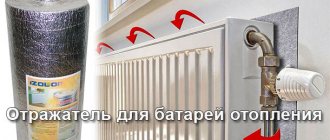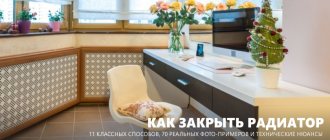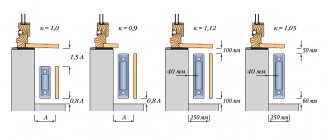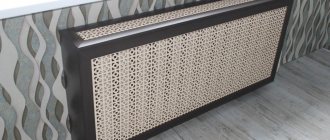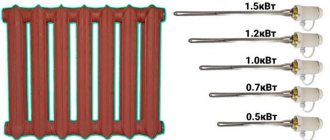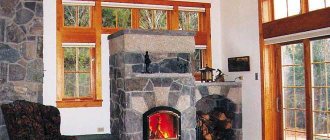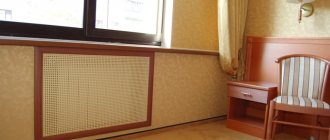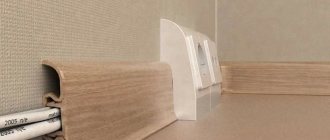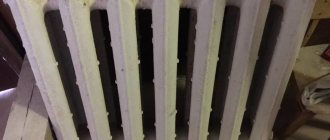The best ways to beautifully hide radiators
There are several ways to hide batteries; in this section we will look at the most popular and effective ones.
Hinged screen
It is by far the most practical and popular method; most often this design is made of metal and has its advantages:
- simple installation;
- heat exchange remains the same;
- can be made with rounded corners, which reduces the risk of injury.
Glass screens
A screen made of glass will be an interesting and stylish solution, especially for those who choose minimalism or a modern style in interior design.
Photo printing or various patterns can be applied to the glass, but this method is not a budget option.
Installation is carried out on a screw holder, but you will have to drill holes in the wall. However, the heating radiator will be stylishly protected. This option will fit into any interior.
Box screens
Box screens are an excellent option for decorating radiators.
- They will help to completely hide the battery.
- The box can become a piece of furniture.
- The screens are easy to install and easy to maintain.
- Protect from burns or other injuries.
Curtains to the floor
Let’s not forget about the most popular way to hide batteries - simply hang them with opaque or translucent curtains. Using this method, over time you will even forget that there are pipes and a radiator behind the curtains.
The main thing is to choose curtains that will look harmonious and not show everyone that there is something behind them.
Painting the walls in color
How to hide a heating radiator on the wall if other designs are “prohibited”. There is only one way to paint it the same color as the wall.
Wood frame
Wood will create coziness and warmth in the apartment, and the disguise of the battery will be elegant and beautiful. This option is for those who are furnishing their home in eco-style using natural materials.
These ways to hide batteries can be used as a stand for home decor.
Built in furniture
Another common way to cover a radiator is custom-made furniture or built-in furniture (shelves, cabinets, folding tables, seating).
Hide the radiator with furniture
Arrange furniture, such as an armchair or desk, so that it covers the radiator. A cast iron radiator is not attractive to many, but pieces of furniture can hide it.
Replace with designer model
For those who don’t want to invent anything, unique designer ways to hide batteries have been developed that already initially have a beautiful appearance and you simply don’t want to hide them.
No. 3. Radiator painting
with painting and decoupage , because it is very easy to cross the line from simply disguising the battery to protruding it. If a radiator with a pattern printed on it contrasts sharply against the background of the wall, it will catch the eye, although initially a completely different task was set. Such a battery seems to suggest that it greatly disturbed the owners, and they tried to hide it.
Designers recommend painting not only the radiator itself, but also part of the wall against which it is located. The drawing can be made in any technique and color scheme. If you have talent, then we pick up paints and start creating: do not forget that the paint must be resistant to heat. If you don’t have any special artistic talents, then you can use ready-made stencils for drawing, use the decoupage technique, or even vinyl stickers . The main thing is that everything looks harmonious, and the battery turns out to be truly camouflaged.
Original ideas
There are many creative ideas that can turn batteries into a decorative element:
Forged products
Hide the radiator with fabric
Painting and decoupage of batteries
Masking of radiators and the laws of heating engineering
The main task of any heating radiator is to heat the room. The goal is achieved by combining or separately using two methods - infrared radiation and convection. Thanks to them, comfortable conditions are formed.
Infrared radiation transfers heat to objects in the room, while convective radiation heats the air.
We can feel thermal energy if we place our hand in close proximity to the radiator. Convection ensures air circulation and uniform temperature distribution throughout the room.
This is known from school physics courses - warm air, rising upward, displaces colder air.
The screen for the radiator performs several important functions: it links the device with the design, protects it from damage and settling dust, the combustion of which releases toxins.
You need to understand that almost any method of hiding pipes and radiators will lead to an inevitable loss of heating power. The simplest example is the use of a glass screen with artistic painting.
It would seem that the task of decorating the radiator was completed successfully, but the room immediately became noticeably colder. This all happened because glass almost completely neutralizes infrared radiation.
An original way to disguise a heating radiator will help to expand the window sill and use the structure as a piece of furniture.
The deeper and more securely the radiator is hidden, the greater the losses will be.
This statement fully applies to blind screens that prevent both long-wave infrared radiation and short-wave convection.
Maximum perforation of the grille and the presence of gaps in the upper and lower parts of the lining are the key to normal convection.
The same can be said about the blind boxes above the top of the radiator - they are an insurmountable barrier to the spread of warm air upward (the convection method does not work). The conclusion suggests itself - the larger the area of the holes in the lining, the smaller the heat loss will be.
Box in the form of a cabinet
You can make the screen useful by making it wider. The top of this design can be used as a tabletop. If you equip the box with doors, shelves, and additional sections for storage, it will take on the appearance of furniture and will be absolutely harmoniously woven into the fabric of the interior.
Yes, yes, there is a heating radiator hidden inside this sideboard
Requirements for the decoration of heating radiators
The availability of pipes and radiators is another important point in choosing decor after the requirements of heating engineering. It is well known that the heating radiator, namely the connection with the pipe, is the weakest point.
In addition, the radiator itself, due to improper installation and operation, or for a number of other reasons, may leak.
In emergency cases, it may be necessary to remove the radiator for repair or replacement. From a plumbing point of view, the cover or screen should not have a fixed attachment, ideally the use of attached screens.
Even if you decide to ignore the advice of a plumber, still listen to the voice of reason, which suggests that any weak point in the system is the connection nodes. The presence of an inspection (plastic door) can significantly simplify the task of servicing the radiator and heating system in the future.
In conclusion
Before deciding how to hide the heating radiator, evaluate the reliability and durability of the system . If it does not inspire complete trust, then the best choice is hanging screens that provide quick access to communications. Old cast iron radiators that have been painted many times, as evidenced by smudges, are best hidden behind screens unless you are prepared to remove old layers of paint and sand the surface.
The article was written for the site.
Tags:Heating radiator
How to close batteries correctly - technical rules and tips
Before closing the radiator, you need to take into account several technical nuances:
- Keep in mind that the heat transfer of a closed radiator is reduced in any case, no matter what masking method you choose. The main thing is that the change is not significant.
Ideally, the decrease in air temperature in the room should be about 1-1.5 degrees.
- Before closing the battery, put it in order: blow it out, wash it (this is done at the end of the heating season) and paint it.
- Keep in mind that the denser the grille weave, the better it masks the radiator, but the worse it conducts heat. Therefore, when choosing a screen for a battery, try to look for a middle ground or rely on heat saving.
- To minimize heat loss, the screen can be placed on legs and a groove can be cut in the center.
When closing the battery, it is very important not to block convective air flows, otherwise it will blow in the room and the windows will begin to fog up, which will ultimately lead to the appearance of mold on the walls. Ideally, the window sill visor should protrude no more than 30 mm above the radiator; the top and bottom of the radiator should be as open as possible.
- There should be a distance of at least 35-50 mm between the battery and the screen. There should be a gap of about 60-70 mm from the radiator to the floor and to the window sill.
To resolve emergency situations, it is necessary to provide free access to the radiator. For example, the box grille can be removable, folding, opening on hinges or retractable on profiles.
At a minimum, for trouble-free maintenance, the following must remain in good accessibility: pipe connections, valves, thermal head and threaded connections.
You can increase heat transfer by 20-25% by placing a heat-reflecting screen, for example, fumisol, on the wall behind the radiator. Often this is quite enough to completely compensate for the heat loss of a closed battery.
What to consider when masking a battery
Before you start masking, you need to know a few important nuances:
- The first thing you need to understand is that with any method there will be heat loss.
- Convection air flows should not be blocked by anything; this is the only way to maintain uniform heating of the room, and the windows will not fog up.
- For various emergencies, it is worth considering in advance free access to threaded connections and the radiator - this could be a window or a removable structure, for example, a door with hinges.
- For repairs, the faucet, thermal head and other elements of the heating system must remain in good accessibility.
Hide with drywall
Separately, I would like to talk about how you can hide batteries using drywall. It’s worth noting right away that the material has its drawbacks, but plasterboard construction is still very popular for repairs.
- The material is environmentally friendly and is not subject to combustion.
- You can find several varieties of this material on the market.
- This camouflage option is budget-friendly, and installation can be carried out in different ways, in a way that is convenient for you.
- Also, it is drywall that will allow the apartment owner to come up with any design, which will help not only to cover the pipes and radiator, but also to make additional decorative elements.
The downside is that drywall is afraid of external influences; if you do it carelessly, it is quite easy to break or pierce it.
And if a breakdown or leak occurs, the entire finish will have to be replaced again, but this material is cheap.
No. 7. MDF, chipboard and plastic screens
MDF panels are not inferior to wood, and in some even superior to it; at the same time, they cost 60-70% less and are not so susceptible to changes in humidity and temperature. Externally, such panels can be painted, veneered or laminated, so the variety of appearance is enormous. It is better to select a screen so that it resonates with other elements of the room.
Chipboard screens are not very common due to their not very outstanding performance qualities. Externally, they are not bad, but for use in a residential apartment it is necessary to choose chipboard with a formaldehyde emission level of E0 or E1.
Plastic screens amaze with their variety and low price. The main thing is to make sure that the material is safe by studying the accompanying documentation. For screens, plastic should be used that can easily withstand heat up to 60-800C. Such products are great for bathrooms, as they are hygienic and do not require maintenance.
Do-it-yourself installation of a plasterboard box
In order to close the battery, you need to measure it, and then buy metal profiles and other additional products.
What materials are needed:
- 12 mm plasterboard sheet,
- metal profiles 27x28 and 60x27,
- self-tapping screws for drywall and metal,
- dowel-nails size 6x40,
- construction serpyanka,
- perforated corners.
Tools:
- screwdriver,
- hammer drill,
- metal scissors,
- stationery knife,
- construction stapler,
- pencil,
- roulette,
- building level.
Attention , for the construction of a plasterboard box there is an important requirement : the window sill must extend beyond the radiator by at least 3 centimeters.
Work order:
Installation of the frame. The profile should be mounted on three adjacent sides: floor, wall, window sill.
- Press the 27x28 metal profile to the base with your hand, drill a hole using a hammer drill in both the profile and the wall.
- Using a screwdriver, screw the dowel-nail into the hole.
- At the bottom of the window sill, a 27x28 metal profile is mounted on self-tapping screws; the length of the screws should not be greater than the thickness of the window sill.
- Next, you can install jumpers made of metal profile 60x27.
Selecting the grid size. This hole must be made slightly smaller than the grid size.
You can focus on three recommended sizes: 60x120, 60x90 or 60x60.
Installation of drywall. Plasterboard sheets can be cut with a utility knife. Screw it in with a screwdriver.
Installation of corners. They must be secured at the corners with a construction stapler, or attached to gypsum plaster.
- Serpyanka should be applied to all seams of the plasterboard box and covered with plaster.
- Before painting or wallpapering, the plasterboard box must be puttied, sanded and coated with primer.
Hide behind furniture
In front of the radiator, at some distance from it - for the same air circulation, you can put a small sofa, chest of drawers or console - anything, the height of the window sill and the width of the radiator or wider. This method does not require any costs, only rearranging the furniture.
It is better not to place very deep objects near the radiator, so that it is still convenient to open the window. This is definitely not the place for the head of the bed: the proximity of radiators will cause headaches, not to mention simply an uncomfortable temperature during sleep.
Masking heating pipes
It doesn’t matter whether it’s an apartment or a house, a bedroom or a kitchen, everywhere I would like to have a good renovation. Questions immediately arise: how to beautifully hide heating pipes and how can this be done with minimal cost and maximum efficiency?
At the same time, the method of disguise should be truly invisible and unnoticeable, fitting into the room.
The pipe can be hidden inside the wall, or it can also be closed into the floor. Remember that the old heating system should not be hidden in this way; this option is possible after a complete update of all elements.
Box on frame
It is best made from wood, plastic or plasterboard. Do not place the heating pipes close together; there should be at least three centimeters between the box and the pipe.
Hide behind decor
Decoration of pipes in various ways, for example, wrapping them with jute rope. But remember that this reduces heat transfer. Many owners decorate pipes with flowers; this can be done using bamboo with leaves.
Only imagination should work here; even an old pipe can look completely different.
Painting to match the color of the walls
The easiest and most practical method is to paint the radiators or riser in the same color as the walls, but the heat generation will not be reduced.
Hide under the floor plinth
A good invention was the floor plinth, in which you can easily hide batteries located horizontally and low to the floor.
Plastic gratings
Cheap, but at the same time definitely not for residential premises, they will hide the battery/pipe, but when heated they can release compounds dangerous to humans, especially if the panel (grid) is made of cheap plastic by a “gray” manufacturer.
Plastic grilles to hide the battery
Advice! Plastic screens are suitable for non-residential premises, taking into account their resistance to high humidity - for bathrooms.
Photos in the interior of the rooms
Kitchen
The kitchen is the ideal room in which all ways to hide batteries will become practical and convenient.
If the room is small, then you can hide the radiator with the help of a beautiful tabletop or make a folding table, which will fold out when convenient.
Factories of metal-plastic structures offer a large selection of beautiful large-sized window sills that imitate stone, wood and other materials. A modern window sill does not break under weight, is not afraid of external factors, is easy to care for, wipe clean, is not afraid of scratches, and so on.
You can hide any type of battery in this way, including cast iron.
Living room
If the radiator is in a niche, then a wide window sill will help create a work area.
You can place souvenirs, vases or potted flowers on the constructed wooden box. You can also cover unsightly radiators in the living room with thick curtains.
The photo shows a modern living room. In order to hide the radiators, a wooden structure was installed, which also serves as a place for rest, storage and decoration.
Bedroom and children's room
In the interior of a bedroom and children's room, batteries can be used as another place to relax, a tabletop for decorative elements or a workplace.
Bathroom
You can hide the pipes in the bathroom using a louvered door, plastic grilles or a cabinet with opening doors.
We hide heating radiators using wooden, glass or plastic screens.
Hallway
For radiators in hallways, glass screens or wooden boxes are suitable. In a small room, covering the battery is only necessary from a practicality point of view.
This could be a locker for storing shoes, or the battery will become a small coffee table where keys and other necessary items will be stored.
Painting
The easiest way to hide the battery is to simply paint it to match the wall near which the radiator is mounted. You just need to purchase special paint for painting batteries. This is an option when radiators match the overall style of the room
Cast iron radiators look great in a Venetian style interior
Painting a stylish radiator red
How to beautifully decorate radiators
Installing a decorative box to cover heating radiators is not the only solution, and not everyone can come up with something and do it on their own.
There are several more ways on how and with what to decorate radiators under the window.
Radiator painting
One of the important issues in decorating a room is the combination of colors. Well, how can a white radiator look, for example, on a dark wall? Although for some reason white color is considered ideal for batteries...
The choice of heat-resistant paints on the modern construction market is huge; all that remains is to choose the right shade and tint the white base.
Even if you don’t guess the shade by a couple of tones, it’s okay, such a difference seems not noticeable at all. But it will still be better than just white. Well, if you wish, you can also manually paint the batteries, especially if there is an ornament on the wallpaper. To make the work easier, you can use a stencil.
Remember: if you decide to paint the radiators in your apartment, buy only heat-resistant paints.
By the way, you can paint not only ordinary cast iron radiators, but also steel, bimetallic, and aluminum ones.
Fabric screen
Another decor option is sewing and attaching a fabric screen screen. This masking method has been tested and is quite effective in terms of minimal heat loss, since the fabric, even the densest, still allows warm air to pass through (unlike a hard screen).
Previously, when heavy curtains were in fashion, all the radiators and the pipes suitable for them were hidden behind them.
And now, when Roman or roller blinds that do not reach the floor are used everywhere, we have to invent something. A practical solution is to attach Velcro to the bottom of the window sill and sew the other half of the adhesive tape to the fabric to create a removable fabric screen.
You can choose the material for it according to your taste and financial capabilities - from thin curtains, to natural linen or cotton, or vertical strips of blinds. The only condition is that the fabric can withstand temperatures up to 60 degrees.
Well, having arranged the space under the window in this way, you can choose roller blinds or window blinds as protection from the sun, without worrying about the unsightly appearance of radiators.
Heating battery box
Most often, such structures are either mounted on the wall or are attached, making it easier to maintain communications. Such boxes are made mainly from MDF, chipboard, wood or plywood.
The first option is the most practical, since MDF does not dry out and is not exposed to temperature changes, and it can be given any shape.
A prerequisite for such a design is the presence of perforations (holes), and the larger they are, the more heat will enter the room. There must be a hole at the bottom for the influx of cold air, and at the top for the exit of warm air.
You can use ordinary wooden blocks as a frame for the box, and if you have the skills of a carpenter, you can build a box according to individual dimensions: it can be either a structure the entire width of the room, covering both the radiator and pipes, or a box covering only the radiator.
Usually, the installation of a box that hides radiators is accompanied by dusty work, so you need to think through the design and create a sketch at the beginning of the repair. A decorative box can not only hide nondescript radiators that are unnecessary to the eye, but also become an element of interior decoration.
Hard screen
The most common (but, unfortunately, not the most practical) solution is to install a hard screen; hardware stores even offer ready-made solutions from a variety of materials. Each of them has its own disadvantages and advantages over others.
- Made of metal. For production, as a rule, stainless steel is used, followed by painting or chrome elements. Such structures look like ordinary mesh boxes. Of course, a metal object under the window is not suitable for every room; the ideal style for such a solution is hi-tech or loft.
But this design conducts heat well and will last a long time.
- Made of wood. Wood has always been considered a win-win option, as it fits into almost any interior. Wooden screens are a structure in the form of wooden lamella panels, horizontal or vertical, located at a sufficient distance from each other. Thanks to good perforation, such a grille does not interfere with proper convection; a wooden screen for a heating radiator will be a reasonable solution.
The only condition is that it must fit perfectly into the environment. This can be achieved by making a custom-made design with tinting to match the furniture.
- Made from glass, it will fit perfectly into the interior of any room. The glass can be frosted or colored, almost completely covering the radiator, or it can have a pattern that matches the style of the room. However, along with the elegant and airy appearance, there is one huge drawback - heat loss in the absence of perforation will almost double. Even the thermal gap at the top and bottom of the screen does not help the situation.
You can improve air circulation by using not solid glass, but glass panels located at some distance from each other.
- From plasterboard. Of course, we are talking, rather, about drywall as the basis of the screen itself, and with the help of other materials you can make a decorative panel-overlay that covers the batteries flush with the box itself.
When installing such a structure, you need to remember all the laws of heating engineering and safety, leaving access to communications in the event of a leak or the need to replace batteries.
No. 5. Glass screen for radiator
One of the most modern options for masking a heating radiator is the use of a glass screen. They are made from durable tempered fire-resistant glass with machined corners, so the screen will not easily get hurt or break. This method of masking is not capable of significantly disrupting the spread of heat flows throughout the room and will fit into almost any interior style and any room.
The glass screen is quite easy to install; it is mounted on special screw holders, which are necessarily equipped with elastic gaskets that protect the glass surface. Caring for such a screen is minimal and consists of periodically cleaning it from dust and fingerprints, using glass cleaning products. The only drawback is the price.
To be able to hide a radiator using glass, you need to pay attention to the method of decorating the surface. Of course, you shouldn’t leave the glass without a pattern: in this case, the outline of the radiator hiding behind the screen will be clearly visible, and the screen itself will play the role of attracting attention to the battery. It would be advisable to at least give the glass some tint. Among the ways to decorate glass are:
- photo printing You can apply absolutely any design to the glass, even a photograph you took yourself, so you can perfectly fit the screen into the existing interior;
- stained glass You can use expensive stained glass techniques (fusing, Tiffany technique or faceted stained glass), or you can create a pseudo-stained glass window on glass using films or paints, which is much cheaper, but the effect will not be worse. Another option is sandblasted stained glass, perfect for modern interiors;
- independent decoration. Usually, screen decoration is entrusted to companies specializing in this matter, but you can decorate an ordered matte screen with your own hands. This is a sticker for stained glass films, rhinestones, etc.
The same rule applies to glass screens as to hanging metal screens: it must fit harmoniously into the space under the window, so it is advisable to choose glass with a width equal to the width of the window sill. If you highlight only part of the space under the window sill where the battery is located with glass, you will get the opposite effect to what you expected.
Examples in different interior styles
Modern style
For a modern style or a high-tech and minimalist style, any material made of wood, glass (glass panels) or metal is suitable.
Classic style
It is recommended to use natural materials; it is better to opt for a wooden lattice.
Provence
Wood also loves styles such as Provence, country, chalet and eco-style.
Scandinavian
Wooden grilles in light colors will look appropriate in the Scandinavian style.
Loft
In the loft style, old radiators and pipes are most often not covered; they are left on display or replaced with interesting design options.
Cover with curtain
Instead of a screen, you can use fabric. This method makes sense if the battery is recessed into the window opening, then the curtain is simply attached from below to the window sill using Velcro. You can make it from the same fabric as the curtains themselves, or choose a cut to match the wallpaper. This solution looks especially good in vintage and rustic styles.

